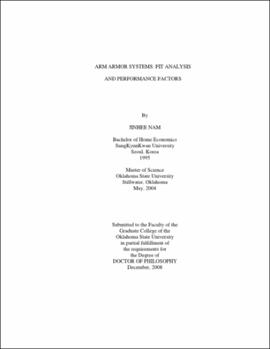| dc.contributor.advisor | Branson, Donna H. | |
| dc.contributor.author | Nam, Jinhee | |
| dc.date.accessioned | 2013-11-26T08:23:22Z | |
| dc.date.available | 2013-11-26T08:23:22Z | |
| dc.date.issued | 2008-12 | |
| dc.identifier.uri | https://hdl.handle.net/11244/6704 | |
| dc.description.abstract | Scope and Method of Study: The purpose of this study was to compare the performance effects and perceptual responses of subjects wearing three different arm armor systems versus no arm armor. Armor treatment with four levels (control garment and arm armor systems A, B and C) and shoulder/arm movement treatment with five levels (flexion, extension, abduction, horizontal flexion, and horizontal extension) constituted the independent variables. There were five dependent variables: range of motion (ROM), localized pressure, garment impediment perception, wearer acceptability, and visual armor coverage. Ten volunteer healthy males, ranging in age from 19 to 30 years, who wore size medium battle dress uniform with recent experience serving in the military or in the Reserve Officers' Training Corps served as subjects. This experimental study contained two major sessions: 1) a one-hour "Pre-test procedure", and 2) a two-hour "Test procedure". Subjects were instrumented with localized sensors and performed five selected shoulder and arm movements in a 3D body scanner chamber while wearing each of the armor treatments. Data for five dependent variables were gathered simultaneously. | |
| dc.description.abstract | Findings and Conclusions: The dependent variables were analyzed primarily using one and two-way repeated measures ANOVA. For localized pressure, no significant main effects for armor system nor for movement in areas 1 and 2 were found, possibly due to several methodological issues. Significant main and interaction effects were found for ROM. There was a trend for ROM to decrease from subjects wearing the control to system A to system C to system B for all five movements. For wearer acceptability, no significant differences were found between the control and system A for all eight items, indicating that subjects did not perceive a difference between wearing the control and the control plus arm armor. There was a trend for wearer acceptability to decrease from wearing the control armor to system A to system C to system B. For visual armor coverage, significant main and significant interaction effects were found. Mean differences were apparent between system A and system B with system A providing more coverage except for flexion. | |
| dc.format | application/pdf | |
| dc.language | en_US | |
| dc.rights | Copyright is held by the author who has granted the Oklahoma State University Library the non-exclusive right to share this material in its institutional repository. Contact Digital Library Services at lib-dls@okstate.edu or 405-744-9161 for the permission policy on the use, reproduction or distribution of this material. | |
| dc.title | Arm armor systems: Fit analysis and performance factors | |
| dc.contributor.committeeMember | Cao, Huantian | |
| dc.contributor.committeeMember | Shehab, Randa | |
| dc.contributor.committeeMember | Peksoz, Semra | |
| osu.filename | Nam_okstate_0664D_10582 | |
| osu.accesstype | Open Access | |
| dc.type.genre | Dissertation | |
| dc.type.material | Text | |
| thesis.degree.discipline | Design, Housing and Merchandising | |
| thesis.degree.grantor | Oklahoma State University | |
